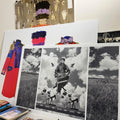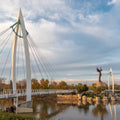The American West as seen through the experiences and artwork of Chinese American artists
By Medicine Man Gallery on
Queering the cowboy at the Museum of Contemporary Art in Denver. A focus on Black cowboys at the Harwood Museum of Art in Taos. The “forgotten men” of the Great Depression at the BYU Art Museum.
In 2023 alone, museums across the West and those focused on the West have made great strides in expanding the stories they’re telling. This newfound emphasis goes beyond the traditional chuckwagon and cattle drive to include a more comprehensive set of experiences.
 James Museum of Western and Wildlife Art 'From Far East to West' installation view. Courtesy of The James Museum
James Museum of Western and Wildlife Art 'From Far East to West' installation view. Courtesy of The James Museum
The James Museum of Western and Wildlife Art in St. Petersburg, FL is the latest in line with “From Far East to West: The Chinese American Frontier,” a captivating journey through time, culture, and identity, showcasing the remarkable history and contributions of early Chinese Americans in transforming the landscape and character of the American West. The exhibition features the work of five contemporary Chinese American Artists: Hung Liu, Mian Situ, Jie Wei Zhou, Benjamin Wu and Z.S. Liang.
Liang (b. 1953) should be familiar to devotees of Western art. He’s produced highly prized, dramatic, super-realistic depictions of Native Americans for more than 20 years. Situ (b. 1953), Zhou (b. 1962) and Wu (b. 1961), likewise, have shown in western museums and galleries for many years, and live in the West.
Hung Liu (1948–2021) may be a “discovery.” In the brief time since her passing, she has become one of the most celebrated contemporary artists of her era with exhibitions at the National Portrait Gallery, The Jordan Schnitzer Museum of Art at Portland State University, the San Francisco Museum of Modern Art, the National Museum of Women in the Arts, and the Honolulu Museum of Art.
“She became my new favorite artist through researching for this exhibition,” James Museum Curator of Art Emily Kapes said. “I was not aware of her work before I started gathering paintings and just fell in love with it. She was so thoughtful, and her work had so many layers and I gravitated to it.”

Liu is just the sort of artist the Western art world–museums, galleries, collectors, media–should be embracing to keep the genre lively and relevant. She’s a brilliant painter who lived in the West, worked in the West, painted the West and offers a vital perspective on the region mostly overlooked by traditionally “Western” art. Four of her paintings appear in the show.
Liu, and the other artists featured in “From Far East to West,” don’t simply provide a more diverse perspective through which to consider the West, they provide a more comprehensive and accurate perspective. The story of the West cannot be told without Chinese immigrants and they’re descendants. Period. But that experience has scantly been represented in Western art.
Same for the Japanese American experience. The Chicano experience.
“The West was about so much more than cowboys, wagon trains, and fur traders. Until recently, minority voices and narratives have rarely made it into mainstream film, art, or publications, so, their contributions to our country are not often celebrated—or even realized,” Kapes said. “This exhibition is a chance to illuminate early Chinese American history and culture. Rich stories of hope, struggle, hard work, and resiliency are threaded through the art and objects.”
These artists aren’t only Western, but they are surely Western as well. The Western art community would be wise to welcome them under the tent, again, that is, if the genre seeks to remain vital and relevant.
About the Exhibition
Kapes curated the show in consultation with the Suncoast Association of Chinese Americans of Tampa Bay. The entire exhibition features Chinese translations alongside English text, a first for The James Museum.
The Westward expansion of European American settlers during the 19th-century is a well-known chapter in American history. “From Far East to West” reveals a parallel development of the West Coast, catalyzed by the discovery of gold in the mid-1800s. From the Gold Rush and the Transcontinental Railroad to the development of Chinatowns and Angel Island–the Ellis Island of the West–artwork and artifacts in the exhibition cover a time period from the 1850s through about 1940.

The contemporary work of these Chinese American artists transports guests back in time to gain insight into what life was like for early Chinese immigrants who helped build the American West.
Often drawing inspiration from their own—more recent—immigration stories and using historical documentation as their guide, the contemporary Chinese American artists’ paintings along with historical artifacts featured in “From Far East to West” create a rich narrative tapestry speaking to culture, identity, and community, and how the past can impact the present.
An additional section of the exhibition spotlights Liang, whose fascination with the history of his adopted country led him to a career painting 19th century Native American life. Liang also draws on his immigration story and finds his way to depict the lives of Indigenous Americans, offering guests another opportunity to contemplate what it means to be an American.
A Movement, not a Moment
Kapes and The James are committed to an ongoing expansion of the boundaries of Western art.
“I think we are on the right track with diversifying our special exhibitions and programs,” Kapes said. “Visitors are often surprised at the variety we share and what Western art can be. When the museum opened a few years ago, I did not imagine curating a show with Chinese language translation and tours, but here we are.”

Future exhibitions centered around Native American fashion, Indigenous Futurism, and Transcendentalism are planned, along with a show centered on the Southwestern borderlands debuting next fall, “Icons and Symbols of the Borderlands.”
“We've gotten a lot of really great feedback for the diverse exhibitions that we've put on and people seem surprised,” Kapes said. “They walk in and think they're going to see John Coleman bronzes, and we've got those, we've got 17 of them on view, and they're amazing, he's a tremendous artist. And we've got some Howard Terpning paintings, and we've got some Ken Riley's, but it's important to show other perspectives, and people have been pleasantly surprised at the style variety, at the artist variety, at the artist’s backgrounds, and just the (different) approaches to Western art.”
“From Far East to West: The Chinese American Frontier” can be seen at The James Museum through January 28, 2024.



